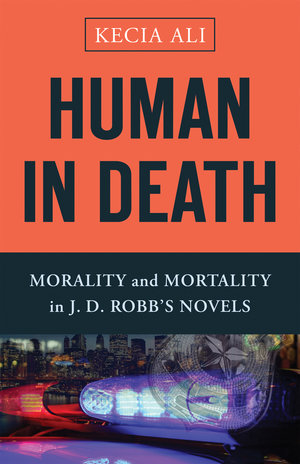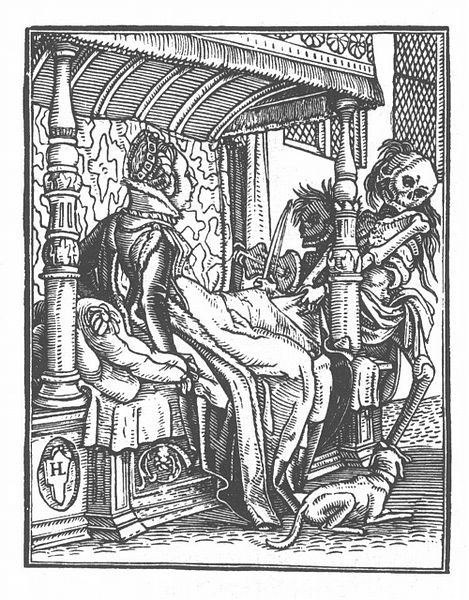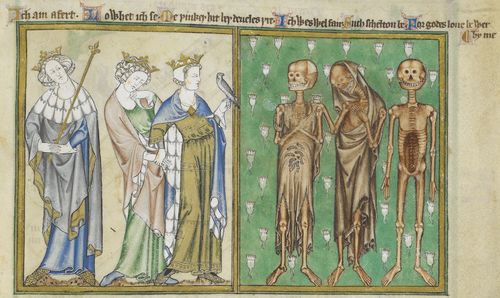There is a moment in J. D. Robb's Celebrity in Death in which, Kecia Ali observes, Robb seems to "address the place of fiction - her own work - in the world" (152) through the words of an actor who states that:
"I'm good at my work. I'm damn good at it and I feel strongly what I do is important [...] without art, stories, and the people who bring those stories to life, the world would be a sadder, smaller place." (46)
Robb's work may make the world a happier place by entertaining her readers, but perhaps she also expands their world by touching on a range of quite serious topics.
 Kecia Ali's Human in Death: Morality and Mortality in J. D. Robb's Novels argues that the novels in Robb's In Death series
Kecia Ali's Human in Death: Morality and Mortality in J. D. Robb's Novels argues that the novels in Robb's In Death series
explore vital questions about human flourishing.
Through close readings of more than fifty novels and novellas published over two decades, Ali analyzes the ethical world of Robb’s New York circa 2060. Robb compellingly depicts egalitarian relationships, satisfying work, friendships built on trust, and an array of models of femininity and family. At the same time, the series’ imagined future replicates some of the least admirable aspects of contemporary society. Sexual violence, police brutality, structural poverty and racism, and government surveillance persist in Robb’s fictional universe, raising urgent moral challenges. So do ordinary ethical quandaries around trust, intimacy, and interdependence in marriage, family, and friendship.
Ali celebrates the series’ ethical successes, while questioning its critical moral omissions. She probes the limits of Robb’s imagined world and tests its possibilities for fostering identity, meaning, and mattering of human relationships across social difference. Ali capitalizes on Robb’s futuristic fiction to reveal how careful and critical reading is an ethical act.
For example, although Robb's protagonist, Eve Dallas, "frequently uses violence in appropriate and measured ways to stop criminals or protect herself, colleagues, or civilians," Ali highlights the need to read carefully and critically given that at other times Dallas
abuses her power, or threatens to. Readers - like Dallas' colleagues - become complicit in these casual brutalities. Readers identify with Dallas and root for her. She has suffered traumatic violence herself and commands what P.D. James terms "reader identification and loyalty." [...] Reader loyalty means that when she hurts people, especially but not only when they hurt her first, readers tend to be on her side.
This is the case even when she is in the wrong. (89)
In such circumstances, the novels may prompt the reader to adopt positions which Ali regards as unethical. However, Ali looks more favourably (albeit still with a critical lens) at other aspects of the novels, such as Dallas's rejection of "the claim that some people simply deserve better lives than others" (96).
Death, too, is portrayed as egalitarian:
In December 2060, Dallas' detectives hang a sign over the squad's break-room door, joining a jumble of holiday decorations [...]:
NO MATTER YOUR RACE, CREED, SEXUAL ORIENTATION, OR POLITICAL AFFILIATION, WE PROTECT AND SERVE, BECAUSE YOU COULD GET DEAD.
Erected as a joke, the sign strikes Dallas' fancy. She decrees that it will remain after the sad Christmas tree and other seasonal debris are gone. It expresses a core truth: death equalizes [...] Not only is death universal, so is vulnerability. (95)
Naturally (given my academic background) this reminds me of medieval and early modern depictions of death.
In the illustrations and texts of the Dance of Death, individuals from both lay and clergy, of high to low estate, of a variety of creeds (at least in the Spanish version), young and old, male and female, are forced to join the dance.
 Death and the Duchess: Holbein d. J.; Danse Macabre. XXXVI. The Duchess
Death and the Duchess: Holbein d. J.; Danse Macabre. XXXVI. The Duchess
The illustration above, by Hans Holbein, dates from the first half of the sixteenth century and depicts two skeletal representatives of Death arriving to take a Duchess from her bed. Other illustrations in the series show the moment at which Death approaches individuals from different social classes. The modern novels of the In Death series use words, rather than images, to portray variations in social class and how they affect the contexts of individuals' deaths:
the form of difference to which the series attends most clearly is class. Juxtapositions between rich and poor victims pepper the series. Its first installment juxtaposes the deaths of a wealthy woman from a prominent family working as a licensed companion and an older LC struggling to get by. Another opens by contrasting two murders: in his lavish home, a rich man's "death had come to him on the luxurious sheets of his massive, silk-canopied bed." A poor young woman's death the night before had occurred "on the stained mattress tossed on the floor of a junkie's flop." The surroundings diverge, but the end result is the same: hence the protecting and serving that the squad sign proclaims. (95-96)
That "squad sign" with its warning that "YOU COULD GET DEAD" also recalls for me the warning issued by three corpses (who are, however, a little more emphatic about the issue), in the tale of The Three Living and the Three Dead: they tend to state some variation of "What you are now, we once were; what we are now, you shall be" (as at Santa Maria della Concezione dei Cappuccini).
 Three Living and Three Dead: Detail of a miniature of the Three Living and the Three Dead, from the De Lisle Psalter, England (East Anglia), c. 1308 – c. 1340, Arundel MS 83, f. 127v (see the British Library blog for more details)
Three Living and Three Dead: Detail of a miniature of the Three Living and the Three Dead, from the De Lisle Psalter, England (East Anglia), c. 1308 – c. 1340, Arundel MS 83, f. 127v (see the British Library blog for more details)
The connection between these medieval/early modern works and the futuristic In Death series may seem tenuous but, as Ali observes "Robb often plays with literary analogues and antecedents [...] e.g. Witness in Death pays homage to Agatha Christie) [...] "Chaos in Death" engages The Strange Case of Dr. Jeckyll and Mr. Hyde" (176) and, in addition, Ali points out ways in which the novels contain more than one "blast from the past" which "connects the future with the past":
Robb's retrograde jargon of "mental defectives" and "violent tendencies" suggests biological determinism [...] the panhandler licenses that beggars must display recall the poor badges of sixteenth-and seventeenth-century England. (106)
It seems not inappropriate, therefore, for an academic response to her work similarly to make connections between her novels and older works of literature and art.
It might be a little bit too fanciful, however, to think of Eve Dallas, who "seeks justice for the innocent and beloved as well as the guilty and the jerks" (114) as a handmaiden of the goddess Poena (from whose name the word "penal" is derived) and of whom Anthony Trollope wrote in Framley Parsonage that:
Poena, that just but Rhadamanthine goddess, whom moderns ordinarily call Punishment, or Nemesis when we wish to speak of her goddess-ship, very seldom fails to catch a wicked man though [...] the wicked man may possibly get a start of her. (Chapter 47)
Even so, it's intriguing how closely and explicitly entwined Dallas' role is with death and, moreover, that it has a spiritual element: "For her, being a cop is a calling. A priest compares Dallas' vocation to his own" (46) and "In a dream conversation with a murder victim who had been posing as a priest, Dallas rejects sin as out of her "jurisdiction," telling him, "Murder is my religion" (151). And it is also mentioned that Dallas was "a 'mythical figure' while [Peabody] was at the [police] academy" (48).
![Poena/Poine: Atreus, king of Mycenae, sprawls mortally wounded on his throne. [...] To the right of the throne [...] P](http://www.vivanco.me.uk/sites/vivanco.me.uk/files/images/Poine (Poena).jpg)
Here "Atreus, king of Mycenae, sprawls mortally wounded on his throne. [...] To the right of the throne [is] Poine, the winged goddess of retribution" who was known as Poena by the Romans. In other words, she's on the scene of a murder to investigate and arrives quickly due to her wings; Dallas has to make do with a flying car. The image is taken from a scene depicted on a "Two-handled jar (amphora) depicting the murder of Atreus. Greek, South Italian, Late Classical Period about 340–330 B.C." Appropriately given Ali's academic affiliation, this is also from Boston, albeit the Museum of Fine Arts. "Images of artworks the Museum believes to be in the public domain are available for download" under terms of use which permit "limited non-commercial, educational, and personal use."
----
Ali, Kecia. Human in Death: Morality and Mortality in J. D. Robb's Novels. Waco, Texas: Baylor University Press, 2017.

Laura, I really appreciate
Laura, I really appreciate the connections you make between medieval and early modern European literature and Robb's futuristic In Death books. The ways in which the future is a (deliberate or unnoticed) continuation of, a (targeted) comment on, or a (selective and partial) repudiation of the past is such a crucial element of the series. I am especially grateful for the reminder of the ways that reflections on human beings' shared mortality are such a central theme in Euro-American Christian pasts--and so much a part of what many folks try to avoid in the present.
"reflections on human beings'
"reflections on human beings' shared mortality are such a central theme in Euro-American Christian pasts--and so much a part of what many folks try to avoid in the present."
Unlike the story of the Three Living and the Three Dead (which is clearly designed to remind people of their own mortality) or books on The Art of Dying (which gave spiritual instruction about how to die well in order to avoid going to Hell after death), the Dance of Death seems to me to have a potentially pleasurable aspect. As with crime fiction, computer games involving shooting/fighting, horror movies, and true crime novels I wonder if some people may have enjoyed the Dance of Death because there's a kind of thrill in vicariously escaping death while others are taken, and there's something carnivalesque in its levelling of the social orders too.
And having come up with those potential modern counterparts, I can't help but wonder, if there's so much death in contemporary popular culture, to what extent are modern people trying to avoid thinking about mortality?